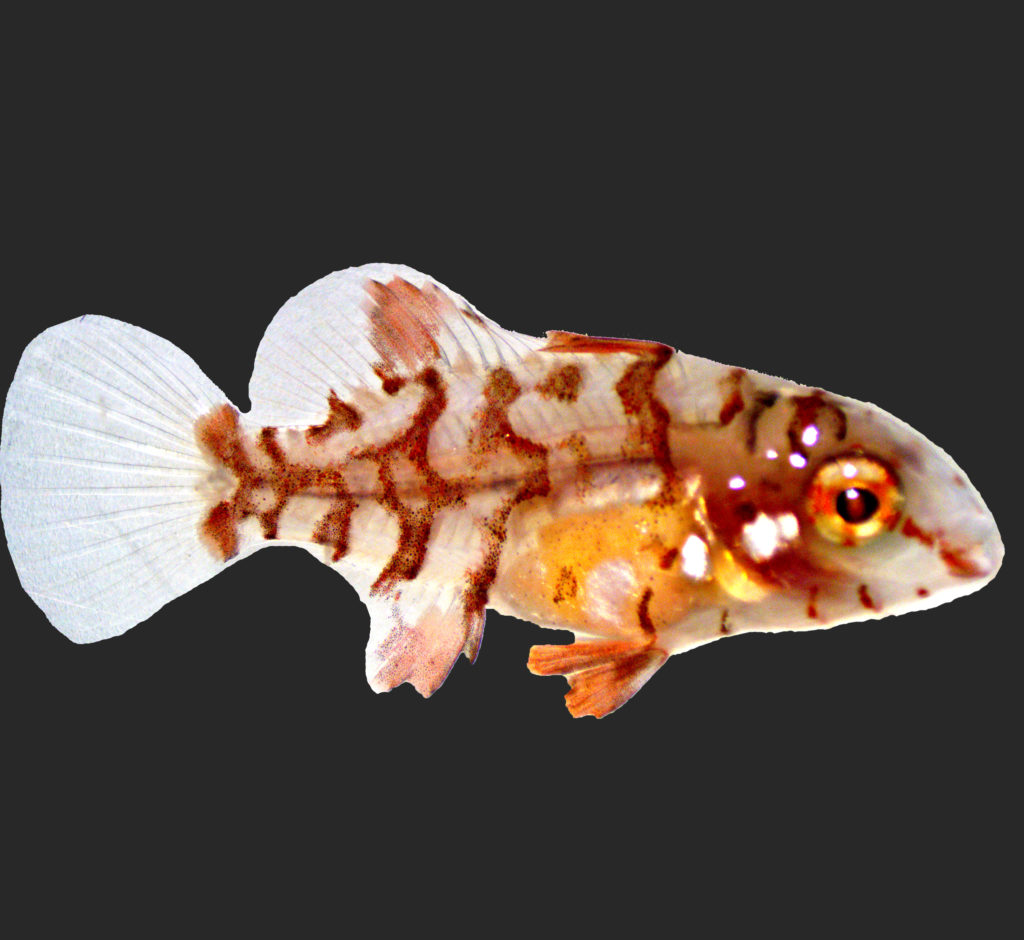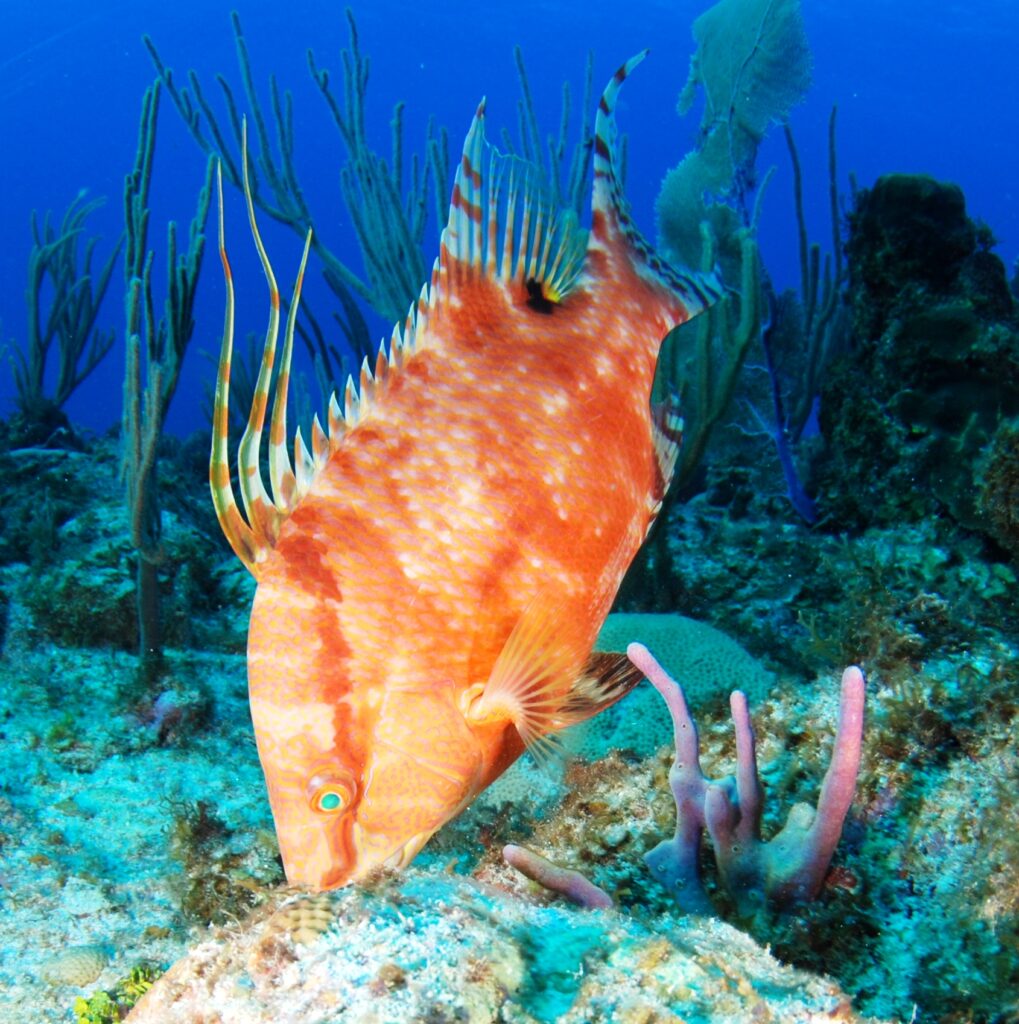
Maximus Hogfish, Lachnolaimus maximus, 42 DPH (Days Post Hatch). Image courtesy Rising Tide Conservation.
Maximus Hogfish, Lachnolaimus maximus, Successfully Aquacultured by UF/IFAS Indian River Research & Education Center
At the end of January 2020, Dr. Cortney Ohs’ Lab at the UF/IFAS Indian River Research & Education Center successfully aquacultured the Maximus Hogfish, Lachnolaimus maximus!
This species is considered a food fish, but is also displayed at public aquaria.
Broodstock
Harems were formed with 4-6 fish in 1500 gallon tanks. Groups were structured around one large assumed male (a fish displaying male physical characteristics, such as an elongated snout and large body size) and several smaller females. Males can be more than double the size of functional females within their harem, which in the wild could contain as many as 15 female fish.
Egg Collection
Viable eggs float on the top of the water column. Eggs were collected daily every morning during a month and a half long spawning period. Spawning periods could potentially be much longer in captivity, but unforeseen circumstances led to the loss of the male in the actively spawning tank.
Eggs were clear with a defined yolk and oil droplet without much pigmentation. Eggs were roughly 1100 microns in size.
Larvae
At hatch, larvae were already almost 3000 microns in length before developing any features like eyes or a mouth. Once the mouth was formed and opened, larvae were able to consume prey items in excess of 150 microns with ease.
Larval Feeding
Larvae were fed starting 2 days post-hatch. For the first 12 days, larval feeding consisted of rotifers and copepod nauplii, with artemia then integrated into the diet. Rotifers and nauplii were phased out over the next week. At day 16 post-hatch, dry Otohime feeds were incorporated into feeding, and by day 45 post-hatch larvae were fed predominately dry diets.
Settlement
Settlement was difficult to define given the space these fish occupied within the water column. By 30DPH most larvae had fully metamorphosed into juveniles and aggregated to floating structures, but it took subsequent weeks for all larvae to aggregate to the bottom of the tank to non-floating structures.
Juvenile Yields
Juvenile yields were over 10% from stocking in some tanks. We are confident yields could be greatly improved after identifying several unique bottlenecks that challenge this species at specific time frames of development.

A subadult Rooster Hogfish feeding on a coral reef. Image credit: Albert Kok, GNU FREE
Application to Other Species
The pattern of harem formation and control we used would apply to many monandric mating systems, especially from the family Labridae (Wrasses) and Scaridae (Parrotfishes). Larger species of both families that would be seen more often in public aquaria would be likely candidates to perform in a similar pattern to Hogfish.

A large Rooster or Maximus Hogfish on display at the National Aquarium of Baltimore. This species commonly reaches sizes of 14″ (30 cm) but has been recorded as large as 36″ (91 cm) and 24 lbs (11 kg), which means this species is primarily relegated to sportfish utilization and public aquarium display. Image Credit: PlanespotterA320, CC BY-SA 4.0
This work was achieved by Dr. Cortney Ohs, post-doc Dr. Elizabeth “Beth” Silvy, and MS student Fred Shopnitz at the Ohs Lab at the UF/IFAS Indian River Research & Education Center, with funding from NOAA.
Watch the juveniles at the lab, 84 days post-hatch as of mid-April:
###
Editor’s Note – This groundbreaking work adds a welcomed bit of knowledge and understanding to what was once a rather limited view of the aquaculture for Lachnolaimus maximus. This species has been on “captive-bred” marine fish lists for years, a holdover from prior lists that were used in the foundation of our own reporting (e.g. https://www.reef2rainforest.com/2013/01/03/coral-magazines-captive-bred-marine-fish-species-list-for-2013/).
In the past, it is not always clear that a “captive-breeding” success from decades prior actually meets the modern definition we apply today. As such, the prior existence of this species on our list as a matter of long-standing history could be validly challenged. With today’s news, we now have a firm, undeniable, documented captive-breeding success which squarely affirms the species’ placement on our lists.
Our congratulations are once again extended to the research team at the UF/IFAS Indian River Research & Education Center.




